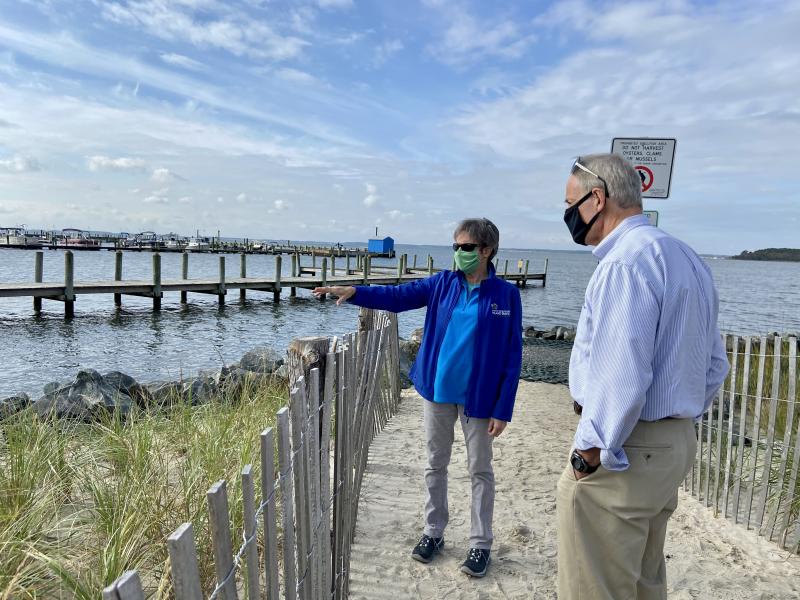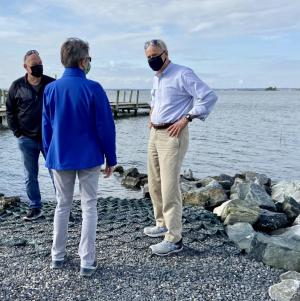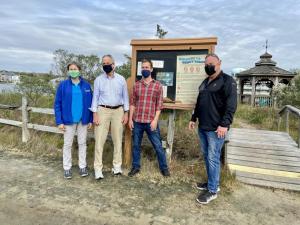Living shoreline system reduces flooding in Dewey

A shoreline stabilization and stormwater management system is reducing flooding on Read Avenue bayside in Dewey Beach, officials told U.S. Sen. Tom Carper during an Oct. 27 tour of the project.
Delaware Center for the Inland Bays Science and Restoration Coordinator Dr. Marianne Walch said frequent storms and super high tides had caused Read Avenue, with a 30-acre drainage area, to experience the worst flooding in Dewey.
The site also experienced sunny-day flooding, CIB Executive Director Chris Bason said.
“You don’t have to be a scientist to know what’s going on,” Carper said, noting officials had recorded the hottest decade ever on Earth and one of the most active Atlantic hurricanes seasons in history, fueled by higher sea surface temperatures.
The project, completed in spring, consists of a living shoreline and three-foot dune, tide gates and outfall pipes, an offshore braided oyster shell reef that stabilizes the shoreline and provides habitats for small animals, and a recreational kayak launch.
Tide gate valves close during high tides, preventing backflow of bay water into the storm drain system. Shoreline riprap and the dune dissipate wave energy that leads to flooding, and sand-filled basket structures stabilize the dune, Walch said.
Dewey Beach Mayor Dale Cooke said he was grateful for the cooperation of CIB, and the state and town officials who collaborated on the project.
Read Avenue resident Phil Winkler said flooding conditions have been dramatically lessened by the living shoreline. Since the shoreline was completed, he said, there have been at least three major high tides of three feet above sea level.
“In the past, that would have caused the bay waters to flow onto Read Avenue, disrupting the lives of all the residents here,” he said. “The new, 3.5-foot berm across the entire beachfront effectively blocks bay waters from flowing onto Read Avenue.”
During heavy rainfall Oct. 12-13, Winkler said Read Avenue received almost two inches of rain during a very high tide, causing flooding on Read Avenue, since rainwater couldn’t dissipate into the bay.
“However, as soon as the tide started to recede, the rainwaters drained quickly away in about two hours,” he said.
Winkler said he tested the newly installed tidal gates three times with dye given to him by his friend, a hydrologist in Texas, and confirmed the gates are working. The dye is sodium fluorescein, which is harmless to humans, fish or any living thing, Winkler said.
“I placed some [dye] on cotton balls inside a weighted plastic bag with holes to permit water to circulate,” Winkler said. “I then placed the dye bag in front of the outlet pipes during the last hour of a rising tide.”
The water around the end of the pipes was a brilliant green while the water above the junction box ashore had no color whatsoever, indicating the tidal gates in the outlet pipes prevented bay water from getting onto the street as they are designed to do, Winkler said.
“Additionally, tide gates in the three drain pipes there only permit waters to flow into the bay and not from the bay into the land,” he added.
Carper said making coastal communities more resilient to the climate crisis is imperative.
“This new natural barrier project will protect nearby residents and businesses from the high tides and higher storm surges we continue to see along the coast as global temperatures rise,” he said. “These are the kinds of investments we need – funding and projects that fortify our communities while restoring habitat and conserving ecosystems.”
Carper said one of his top priorities is to invest more in making communities, transportation, drinking water and wastewater infrastructure more resilient to the worsening climate crisis.
“Natural infrastructure is a smart and effective way to protect communities from the climate crisis, but it only addresses the symptoms of the climate crisis,” he said. “We also need to focus on the root causes of coastal erosion, rising seas and more severe extreme weather.”
Heat-trapping air pollution is warming the planet, Carper added, causing ice caps to melt and sea levels to rise.
“Warmer temperatures and higher sea temperatures are fueling more frequent and destructive tropical storms,” he said. “If we do nothing to dramatically reduce carbon emissions – the villain of the climate crisis – the damage and destruction we’re seeing now will pale in comparison to the devastation that lies ahead.”






















































